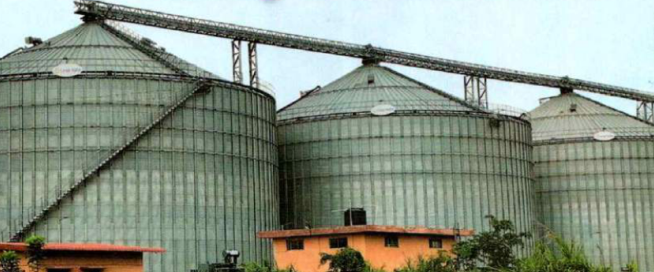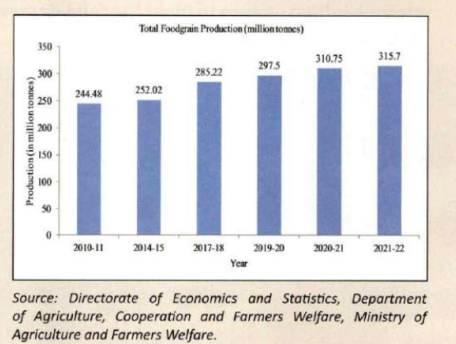ForumIAS announcing GS Foundation Program for UPSC CSE 2025-26 from 19 April. Click Here for more information.
ForumIAS Answer Writing Focus Group (AWFG) for Mains 2024 commencing from 24th June 2024. The Entrance Test for the program will be held on 28th April 2024 at 9 AM. To know more about the program visit: https://forumias.com/blog/awfg2024
A resilient food storage infrastructure holds the key to agri-food systems sustainability in India. It will ensure food and nutrition security for our future generations, and also help us achieve our socio-economic, and environmental development goals.

What is Food Storage Infrastructure Systems?
Storage Infrastructure- Storage infrastructure plays a critical link in the whole system of food grains procurement to its distribution for consumption.
Types of Storage Infrastructure in India
| Traditional Storage Structures | Kanaja, Kothi, Sanduka, earthern pots, Gummi and Kacheri are different types of traditional storage infrastructure in India. 60-70% of grains are stored on the farm in these traditional structures. |
| Modern storage structures | Warehouses and farm silos are the modern storage structures used in India. These are scientific in nature, especially constructed for the protection of quantity and quality of stored products. |
What is the importance of Food Storage Infrastructure System?
1. Avoiding the Post Harvest Losses- As per NABARD study, there are large post harvest losses in the agricultural and allied sectors (Cereals~4-6%, Pulses~6%, Fruits~6-15%). The use of scientific food storage methods can reduce the post harvest losses to as low as 1%-2%.
2. Food Security for the large Indian Population- India’s population is projected to grow to 1.64 billion by 2047. Strengthened storage infrastructure will help to meet the food demand of the population and creation of sustainable food system.
3. Preventing Collapse of Food Supply System- Resilient food storage system will help in preventing a collapse of the food system in the advent of natural calamities (flood, droughts) and outbreak of pandemics like COVID-19.
4. Economic Support to farmers- The storage infrastructure provides economic support to farmers by ensuring better prices for their produce by reducing the need for distress sales.
5. Employment generation- The construction and operation of these storage facilities help in generating local rural employment, thereby boosting rural economies.
What are the Govt Initiatives?
| Integrated Cold Chain and Value Addition Infrastructure scheme | The cold storage capacity of 8.38 lakh MT has been created under this scheme. |
| National policy on Handling, Storage and Transportation of Food Grains (2000) | This policy promoted the participation of the private sector in building warehouses and storage infrastructures. |
| Food Corporation of India (FCI) schemes | FCI schemes like private Entrepreneurs Guarantee (PEG) Scheme, Hiring of godown through Private Warehousing Scheme (PWS) have helped in the creation of 1923 warehouses (Owned/Hired) with a capacity of 371.93 LMT for storage of Central Pool food grains. |
| World’s Largest Grain Storage Plan in Cooperative Sector | The plan entails creation of various agri infrastructure at the Primary Agricultural Credit Societies (PACS) level, like setting up decentralised godowns, custom hiring centres, processing units, Fair Price Shops etc. through convergence of various existing schemes of the Government of India (Gol) under different Ministries. |
| Primary Agricultural Credit Societies (PACS) | PACS has a huge member base of more than 13 crore farmers. NABARD is extending financial support to PACS to create agriculture infrastructure. |
| Tax Benefits | The Income Tax Act, 1961 allows for a deduction of up to 150% on expenditures incurred towards setting up cold storage. The setting up of cold storage is also exempt from service tax and excise duty. |
What are the Challenges in developing Storage Infrastructure?
1. Shortage of Storage Infrastructure- There is shortage of storage infrastructure in India to the tune of 166 MMT. (The total food grain production in India is about 311 MMT and total Storage Capacity in India is only 145 MMT).

2. Prominence of traditional storage infrastructure- 60-70% of grains are stored on the farm in traditional storage infrastructure. However, this Indigenous storage structures are not suitable for storing grains for very long periods.
3. Inefficiency of PACS and agricultural cooperatives- The Primary Agricultural Credit Societies and the agricultural cooperatives suffer from inefficient capacity in executing storage infrastructure works. For ex- Only about 63,000 out of 1 lakh PACS are currently operational in India.
4. Low Private and Govt investment- Despite the focus of government on creation of modern storage infrastructure, the low CAPEX in the annual budget and less private investment has dampened the pace of development of storage infrastructure.
5. Low Skill Levels- The Indian youth lack the necessary skills to operate and manage these advanced storage facilities.
What should be the way forward?
1. Promotion of decentralised local storage systems- The promotion of decentralised local storage system will reduce the wastage of food grains, strengthen food security and prevent distress sales by farmers.
2. Increasing investment in the post-harvest infrastructure- Efforts must be made to increase investment in modernisation of warehousing, logistics, cold chain, food processing, and integrated value chain development
3. Modernization of the existing storage to include horticultural crops- The existing warehousing infrastructure must be modernised to include perishable commodities like fruits, vegetables, milk, meat, fish, etc., which have high post harvest losses.
4. Exploration of PPP and FPO route- The PPP and FPO route must be explored to create modern storage systems in India.
5. Training and Skill Development- The youth must be made skilful by training them in creation and maintenance of modern storage systems in India.
| Read More- The Hindu Businessline UPSC Syllabus- GS 3- Indian Agriculture |




